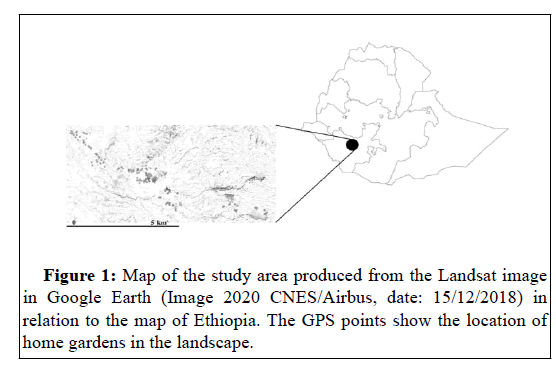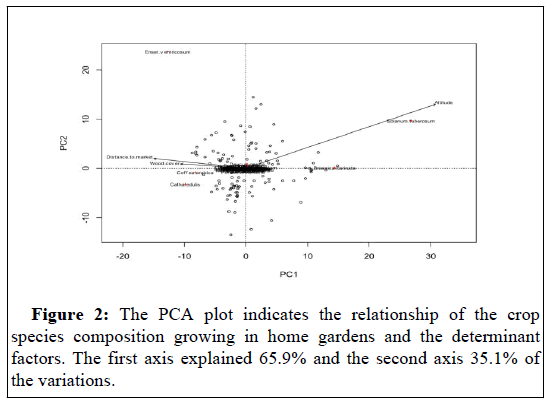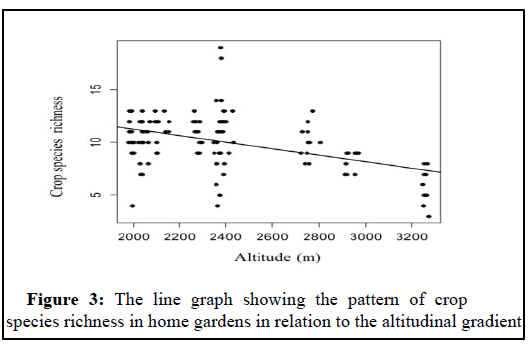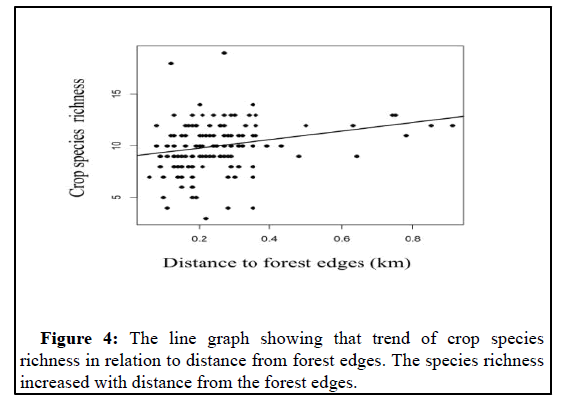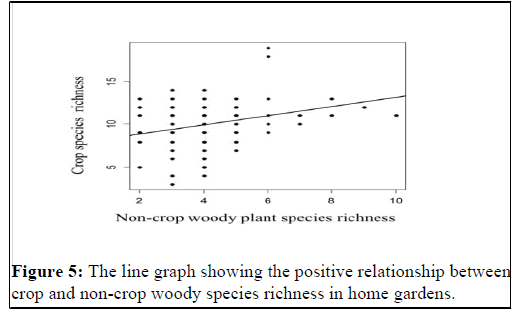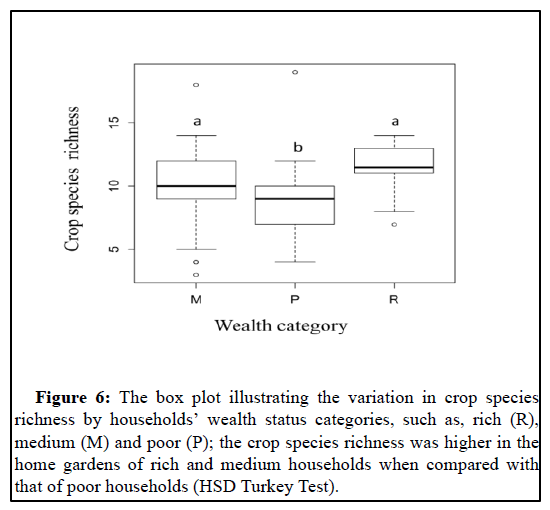Socio-Ecological Determinants of Composition of Crop Species in Home Gardens of Southern Ethiopia
Received: 22-Jul-2021 / Accepted Date: 06-Aug-2021 / Published Date: 13-Aug-2021 DOI: 10.4172/2329-8863.1000476
Abstract
We explored the socio-ecological factors mediating the crop composition in home gardens of southwest Ethiopia. For this, eleven kebeles were purposively selected based on the altitudinal variations that range between 1980-3271 ma.s.l. From each kebele 11 households were randomly selected and in total 121 households were used for the study. Here, a complete plant inventory was undertaken in home gardens along with the socio-economic survey using semi-structured questionnaire. The effects of altitude, woody cover, distance to market and type of crop raiders on species composition was tested using Adonis function. The effects of altitude, woody species richness and home gardens distance to forest edge on crop species richness were tested using Linear Mixed Effect Model within lmer function using R statistical program. The effect of wealth status on crop species richness was tested using One-way ANOVA. Altogether, 45 crop species belonging to 38 genera and 25 families were recorded. The species composition of crops was significantly affected by wood cover in home gardens (P=0.02), altitude (P=0.001), distance to market (P=0.01) and types of crop raiders (P=0.03). Similarly, crop species richness decreased with increasing altitudinal gradient, increased with increasing distance from forest edges and woody plant species richness (P<0.02) and vary among the different wealth categories of the households (P=0.002). Overall, this study denotes that socio-ecological factors determine crop species composition and richness in home gardens of southern Ethiopia.
Keywords: Agro-biodiversity; Agro-ecosystem; Crop composition; Home gardens; Socio-ecological factors; Landscapes
Introduction
Home gardens are most often considered as refugia for both woody plant and crop species in human managed landscapes. Assemblages of plants of different growth habits, such as, trees, shrubs, vines, and herbaceous plants grow in home gardens. According to home gardens are commonly defined as a piece of land with a definite boundary surrounding a homestead cultivated with a diverse mixture of perennial and annual plant species in combination with raising livestock, and managed mainly by household members for subsistence production [1]. With these combinations home gardens are accepted as a sustainable agroforestry system and characterized as proper land use system wherein woody and non-woody species are closely arranged in overlapping canopy layers and sustainable and productive agricultural systems.
The high diversity of species in home gardens provide multitude socioeconomic and agro ecological services, such as, food, firewood, fodders, spices, medicinal plants and ornamentals. Moreover, home gardens preserve cultural history since many useful plant species have been connected to intense human management regimes over extended periods. The daily nutrition and healthy food required by household members can be obtained from agricultural productions in home gardens and hence, home gardens play significant roles in ensuring household food security.
It is estimated that the history of home gardens crop growing practices in Ethiopia goes back to the era of the beginning of agricultural practices during 5000-7000 BC. Considering the long history of agriculture in Ethiopia and the presence of ancient crop domestication in home gardens, it could be presumed that gardening was probably the earliest form of farming ever practiced in the country. Ethiopian home gardens may occupy different positions such as the back yards, front yards, and side yards and yards those almost encircle the house, and have variable shapes and sizes and different composition of plant species.
In Ethiopia, home gardens may broadly be categorized into two types; (1) small-sized cereal crop based home gardens are where vegetables, spices, oil seeds and fruits are cultivated to supplement cereals and pulses raised in adjoining fields, and (2) diversified which is characterized by diverse mixture of crop plants with Enset making the basic framework and such type is commonly found in south and southwestern part of the country 1, 9 within altitudinal range of 1500-2300 ma.s.l.
Enset is a multi-purpose and drought tolerant crop with several hundred landraces (clones) having different characteristics and is used for food, fodder, fiber and traditional medicine. Nutritionally, enset products are rich in carbohydrates but low in proteins and fat content [2]. The Yield of enset depends on the landraces used and with the climatic condition of the given environment. Although several earlier findings have showed the species diversity and composition in home gardens of southern Ethiopia, little was understood about the factors that mediate the crop species composition. Such kind of knowledge could be helpful in designing development and conservation strategies in agricultural landscapes. Here, it was hypothesized that various socio-ecological factors determine the composition of crops in home gardens of south Ethiopia [3]. The present study suggest that different socio-ecological factors such as altitude, wealth status and distance to forest edges and crop raiding determine crop species composition in homegardens of southern Ethiopia and hence such multifaceted factors need to be taken into account in planning agro biodiversity conservation.
Materials And Methods
The study area
The study area was located in Ezha district of Gurage zone of the South Nation Nationality and People’s Regional State (SNNPRS) [4]. The mean annual rainfall ranges between 900-1200 mm while the mean annual temperature of the study areas ranges between 16.5-25oC. The farming system of the study area is largely characterized by small-scale subsistence mixed farming-system consisting of crop cultivation and livestock production (Figure 1).
Sampling design
In the beginning reconnaissance survey was made to obtain a general overview about the farming system and crop growing practices in the study area during 27-31 October, 2018. For this, the district agriculture office was communicated to generate secondary information about home gardens management and socioeconomic characteristics of the local community [5].
Data collection
A complete inventory on woody plant species, annual and perennial crops species was undertaken and the geographical locations (GPS points) were recorded in each 121 home gardens. Accordingly, data on the number of woody and crop species, growth habits of woody species and crop plant use types were collected. The plant specimens which could not be identified in the field were collected for later identification at the national herbarium of Addis Ababa University, Ethiopia [6]. Along with this crop plant assessment, a semi-structured questionnaire survey was undertaken at household level on socioeconomic conditions including age, household size, and wealth status of the households.
Data analysis
After the field work was completed, the GPS points of the home gardens were displayed on satellite image and the distances of each home gardens to the nearest forest patches were measured using ruler in Google Earth. The relationship of the environmental variables and crop species composition was non-hierarchically described using Principal Component Analysis (PCA) within vegan package. To test variation in species composition along altitudinal gradients, woody cover in home gardens, home gardens distance to forest, crop raiding types and off-farm activities [7,8]. Adonis function which is a MNOVA and analogues to ANOVA was used within vegan package (Figure 2). The crop species richness was square-root-transformed to attain the assumption of normal distribution and homoscedasticity. Moreover, altitude was standardized (scaled) to bring to the comparable level with other independent factors. Before the analysis was run the multicollinearity among explanatory variables was checked using the correlation matrix and the factors which did not strongly correlate (r<0.40) were included in one model. In accordance with this, the effects of altitude, woody species richness, wealth status, and distance from forest edge to home gardens on crop species richness were tasted using Linear Mixed Effect Model. In the linear mixed effects model, the independent factors were entered as fixed factors while the 11 kebeles were considered as random factors with the assumption that each site has its own specific factors that were neither measured nor controlled for. To reach at the final model the backward selection procedure was followed in which first all the variables were included in the model and then the model simplification was made by removing one variable at each step that did not contribute to the model and this was stopped when all the factors that significantly contributed to the model. The effect of wealth status of the households on the crop species richness was tested using one-way ANOVA [9]. After we found significant effect of the wealth status on species richness, multiple comparison of the means was made using HSD Turkey test. For all the analyses R statistical program (version 3.5.3) was employed.
Results
Crop plant species richness
The analysis of the linear mixed effects model showed that crop species richness significantly vary with altitude (ranges between 1980-3271 m.a.s.l) in that species richness decreased with increasing altitude in home gardens P=0.004 (Figure 3). Similarly, the crop species richness significantly increased with increased distance from forest edges P=0.02, (Figure 4) [10]. The crop species richness was also significantly affected by the non-crop woody plant species richness in home gardens and it increased with increasing woody plant species richness (P=0.002) (Figure 5).
The crop plant species richness of the home gardens significantly varied among the wealth categories of the households (P=0.007) [11]. The crop plant species richness was higher in rich (R) and medium (M) households when compared with that of the poor (P) households (Figure 6). The mean value (x ± SD) plant species recorded in home gardens of poor HH (13.3 ± 2.3), medium HH (13.4 ± 2.3) and rich HH (13.5 ± 2.4).
Figure 6: The box plot illustrating the variation in crop species richness by households’ wealth status categories, such as, rich (R), medium (M) and poor (P); the crop species richness was higher in the home gardens of rich and medium households when compared with that of poor households (HSD Turkey Test).
Discussion
Species composition
The crop species composition and the number of crop species that the farmers grow in their home gardens are dependent on various socio-ecological factors in southern Ethiopia. The species composition that farmers grow in home gardens of southern Ethiopia was significantly affected by altitude, distance to market, types of crop raiders and non-crop wood cover. The species composition significantly differs among the altitudinal zones. This variation in species composition with elevation differences could be due to the limitations arising from niche quality and suitability of environmental gradients such as precipitation temperature and fertility of the soil. Moreover, the variation in adaptation potential of each specific species could be a determinant factor in species composition dissimilarity in home gardens with elevation gradient. Our result is in agreement with the findings of the previous studies that indicated the dissimilarity in crop species composition along altitudinal gradients.
The home gardens located in close vicinity to local markets had similar species composition when compared with home gardens situated far away from the market. The most likely reason for such trend is that the relatively higher market value of crops nearby markets may lead the farmers to give priority to cash crops growing than other crops and this could mediate the composition of crop species grown in home gardens. Moreover, access to market could be an incentive for the farmers so that they engage in monoculture crop growing practice focusing on income generating crop species, such as, Coffea arabica and Catha edulis. In this connection, the presence of such common practices in Ethiopia was also reported by several earlier studies. The study conducted in Benin suggested that access to market and marketing opportunities may lead to the changes in structure, composition and function of home gardens for farmer’s select crop species to grow based on their market values regardless of the specific land suitability factors.
The crop raiding was found to be one of the factors determining the crop species composition in home gardens. Related to this, in home gardens of the households, who are affected by crop raiders, the crop species composition growing are similar when compared with that of households who are less affected. In this regard, farmers living close to forests explained that they are not interested to use agricultural inputs such as, chemical fertilizers and improved crop varieties as the disadvantage outweighs due to severe crop raiding in these areas (personal communication). Although crop guarding could be practiced, it is a labour intensive and competes with other farm management activities including plowing, weeding, watering and management. Such challenge was also reported be previous finding that crop raiding determine the crop species grown in home gardens and have a negative influence on plant species conservation since it demands farmers to engage in different process and mitigation strategies.
Among the ecological factors influencing species composition in home gardens is non-crop woody species richness. Here, our result showed that crop species richness and non-crop woody species cover were positively correlated. In this nexus, the existence of higher noncrop woody species richness in agro ecosystems may promote the roles for micro-organisms in enhancing the production and productivity of crops. Likely, non-crop woody species can also be source habitats for pollinators as well as for predators of crop pests in that the yield may be boosted and this in turn could be an incentive for crop growers and such system was also denoted by from Tigray region that woody tree species are source habitats for agriculturally important pollinator and predator species in agro-ecosystems. Moreover, noncrop woody species also provide regulating ecosystem services, for example, live fences protect crops from raiding besides the benefits that farmers use woody species as wind breaks.
Species richness
The species richness is higher in home gardens located at far distance from forest edges and in home gardens having higher woody species cover in these area, but lower at higher altitudes and in home gardens of poor households. Here, Within the altitudinal rages of 2258-2431 m.a.s.l. the number of crop species we recorded was 19, while only 3 species were encountered at higher altitude areas (>2716 m.a.s.l.). This result shows that the crop growing suitability and farmers’ practices are influenced by altitudinal variation as a factor for the variations in environmental temperature and moisture availability. For example, higher altitude areas (>2716 m.a.s.l.) experience cold weather which may negatively influence the adaptability of crops and hence limiting the diversity of crops growing in these areas. On the contrary, in the areas having mid and lower altitudes (<2431 m.a.s.l.), the humidified environment and optimum rainfall may favor the survival and adaptability of flora and this condition could enhance the diversity of crops growing practices of the farming communities. Our results corporate the earlier findings from Javanese from Indonesia and from Ethiopia that showed higher crop species richness at lower altitudes (<2400 ma.s.l.). Similar trend was observed from Garhwal in Himalaya that at lower altitudes (1850-2250 m.a.s.l.) 9 species were reported and only 2 crop species were recorded in home gardens at higher altitudes (2700-2800 m.a.s.l.). Moreover, in consistent with our finding reported higher crop species richness in home gardens at lower altitudes (1600-1700 m.a.s.l.), lower at higher altitudes of above 3200 m. However, who denoted that altitudinal variation has no significant effect on crop species richness that farmer are growing in their gardens.
In low lying areas of the present study the environment is relatively warmer and drier, the perennial crop species, such as, Enset ventricosum, Coffea arabica and Catha edulis are common but were not encountered at the higher altitudes except that Enset ventricosum sporadically observed in few home gardens. Whereas, the crop species including Brassica carinata, Solanum tuberosum and Lippia adoensis are common at the higher altitudes, but not recorded in home gardens found at lower altitudes. Our result is in consistent with the earlier studies that pointed out that the species richness and the altitude of homegardens are negatively correlated.
Our overall result of crop species richness assessment (45 species) is lower when compared with what was recorded from home gardens of Wolayta (59 species) in southern Ethiopia species from Dawro Zone of Southern Ethiopia species from Enset-coffee agro-forestry home gardens of Southern Ethiopia and 136 species from southwestern Uganda but higher than 37 crop species from home gardens of western Ethiopia and 43 crop plant species in home gardens of Holeta town, Oromia. The variation in crop species richness among home gardens of tropical regions could be due to the variations in socio-ecological factors. For instance, in this study the age of the head of the households, gender, and neither education level nor sizes of home gardens found to significantly influence species richness. However, the present result and other previous findings exhibited inconsistent trends in tropical home gardens. In this regard, our results contradict the previous finding that the age of households head and size of the home gardens were previously reported to significantly determine status of species richness among home gardens from Benin and Ethiopia.
The other reason why the crop species richness was lower in home gardens situated close to forests is that in these areas likely the impact of crop raiding is severe which may discourage the local communities to practice extensive crop growing in their home gardens in contrast, farmers dwelling at far away from forests seldom experience such impact and could grow various crop types and woody species that they need for different purposes. Such trend is similar with the level of woody composition management in home gardens in relation to different distance to forests. For example, households situated nearby forests can easily access resources and less likely maintain composition of plants on their home gardens since they can fulfill their demand for wood from nearby forest.
The cover of non-crop woody species and the crop species richness in home gardens are positively related and this is in congruent with previous findings that denoted a positive relationship between crop species richness and non-crop woody plant species richness in home gardens. Of course, households grow non-crop woody species for varieties of purposes including construction, fuel wood and shade for perennial species such as Coffea arabica maintaining soil fertility, income source, medicine, fodder and fencing. The majority of the non-crop woody species preferred by farmers to grow in home gardens are fast growers, easily propagated and tolerant to regular pruning and it implies that, farmers grow non-crop woody species which have a positive association with crops.
The richness of crop species grown in home gardens is dependent on the socio-economic status of the households. Our results revealed that higher species richness was recorded in home gardens of rich and medium households when compared with that of the poor households. In this angle, our result is in agreement with the findings reported from southern Ethiopia. However, lower number of crop species in “poor” households. One of the determinant factors in this nexus could be the size of home gardens. Moreover, obviously known is poor households have lower access to agricultural inputs such as fertilizer among others to grow diverse crops either in home gardens or in crop fields. In contrast, households that belong to the “rich” and “medium” wealth categories had larger family size and income and grow high diversity of crops in their gardens. This means that, the economically rich and medium households could have greater opportunity to buy essential resources such as space, labor, good management practices (fencing, watering, and weeding) and soil fertility maintenance when compared with the poor households. Our result is in consistent with the earlier studies that pointed out that the species composition and the wealth status of households are directly related. Overall, the present study suggest that different socio-ecological factors determine the crop species composition in home gardens and hence such multifaceted factors need to be taken into account in planning agro-biodiversity conservation in agricultural landscapes.
Conclusion
Agricultural landscapes of southwest Ethiopia are generally heterogeneous wherein diversified farming system is commonly practiced. The socio-ecological factors such as altitude, distance to market, non-crop woody cover and crop raiding were found to be the determinant factors of crop species composition in home gardens. Crop plant species also determined by factors including altitude, distance from forest edge, non-crop woody plant species richness and economic status of households. The species richness showed a decreasing trend with increasing altitude and distance from forest edges and is also positively correlated with non-crop woody species richness and increasing distance from forest edges. Similarly, the crop species richness recorded in home gardens was also dependent on the economic status of the households where households who are better of have maintained higher composition when compared with whom are not. These patterns denote that congruently the socio- ecological factors determine crop species composition and richness in home gardens of southern Ethiopia and such indications could be used as an input for designing biodiversity conservation strategy and policy in agricultural landscapes.
Acknowledgments
We thank Ethiopia Biodiversity Institute and Addis Ababa University for financial support during this research work. Our thanks also go to local communities and administration of Ezha District for their willingness to give us information and support during the whole data collection process.
Conflicts of Interest
There is no conflict of interest.
References
- Mengitu M, Fitamo D (2015) Plant Species Diversity and Composition of the Homegardens in Dilla Zuriya Woreda, Gedeo Zone, SNNPRS, Ethiopia. Plant 3: 80-86.
- Abebe T (2013) Determinants of crop diversity and composition in Enset-coffee agroforestry homegardens of Southern Ethiopia. J Agric Rural Dev Trop Subtrop 114: 29-38.
- Linger E, Asfaw Z, Zewdie S (2014) Plant species diversity of homegardens agroforestry in Jabithenan District, North-Western Ethiopia. Int J Biodivers Conserv 6: 301-307.
- Molebatsi LY, Siebert SJ, Cilliers SS, Lubbe CS, Davoren E (2010) The Tswana tshimo: A homegardens system of useful plants with a particular layout and function. Afr J Agric Res 5: 2952-2963.
- Mekonen T, Giday M, Kelbessa E (2015) Ethnobotanical study of homegardens plants in Sebeta-Awas District of the Oromia Region of Ethiopia to assess use, species diversity and management practices. J Ethnobiol Ethnomedicine 11: 64.
- Regassa R (2016) Useful plant species diversity in homegardens and its contribution to household food security in Hawassa city, Ethiopia. Afr J Plant Sci 10: 211-233.
- Daba D, Dale G (2020) Ethnobotanical study of multipurpose plants in ENSET-based home gardens of Angecha District, Southern Ethiopia. Biodivers Int J 4: 18-27.
- Woldemichael G, Chimdessa M, Abebe A (2016) Species diversity and use of homegardens in Misha woreda, Hadiya zone of SNNP, Ethiopia. Int J Agricul 2: 118-129.
- Woldeamanual W, Asfaw Z, Lemessa D (2018) The Effect of the Surrounding Landscape and Socioeconomic characteristics on Woody Species Diversity in Homegardens of Shewarobit District, Northeast Ethiopia. Smal-scal Forest 17: 471-483.
- Chawla A, Raj KS, Singh KN, Brij L, Singh RD (2008) Plant Species Diversity along an Altitudinal Gradient of Bhabha Valley in Western Himalaya. J Mt Sci 5: 157-177.
- Lemessa D, Asmelash F, Teka Y, Alemu S, Didita M, et al. (2017) Woody Species Composition in Relation to spatial and Environmental Gradients in Acacia-Commiphora Vegetation Ecosystem of Ethiopia. Int J Natu Res Ecol Manag 2: 53-59.
Citation: Getachew E, et al. (2021) Socio-Ecological Determinants of Composition of Crop Species in Home Gardens of Southern Ethiopia. ACST 9: 476. DOI: 10.4172/2329-8863.1000476
Copyright: © 2021 Getachew E, et al. This is an open-access article distributed under the terms of the Creative Commons Attribution License, which permits unrestricted use, distribution, and reproduction in any medium, provided the original author and source are credited.
Select your language of interest to view the total content in your interested language
Share This Article
Recommended Journals
Open Access Journals
Article Tools
Article Usage
- Total views: 3215
- [From(publication date): 0-2021 - Dec 22, 2025]
- Breakdown by view type
- HTML page views: 2364
- PDF downloads: 851

